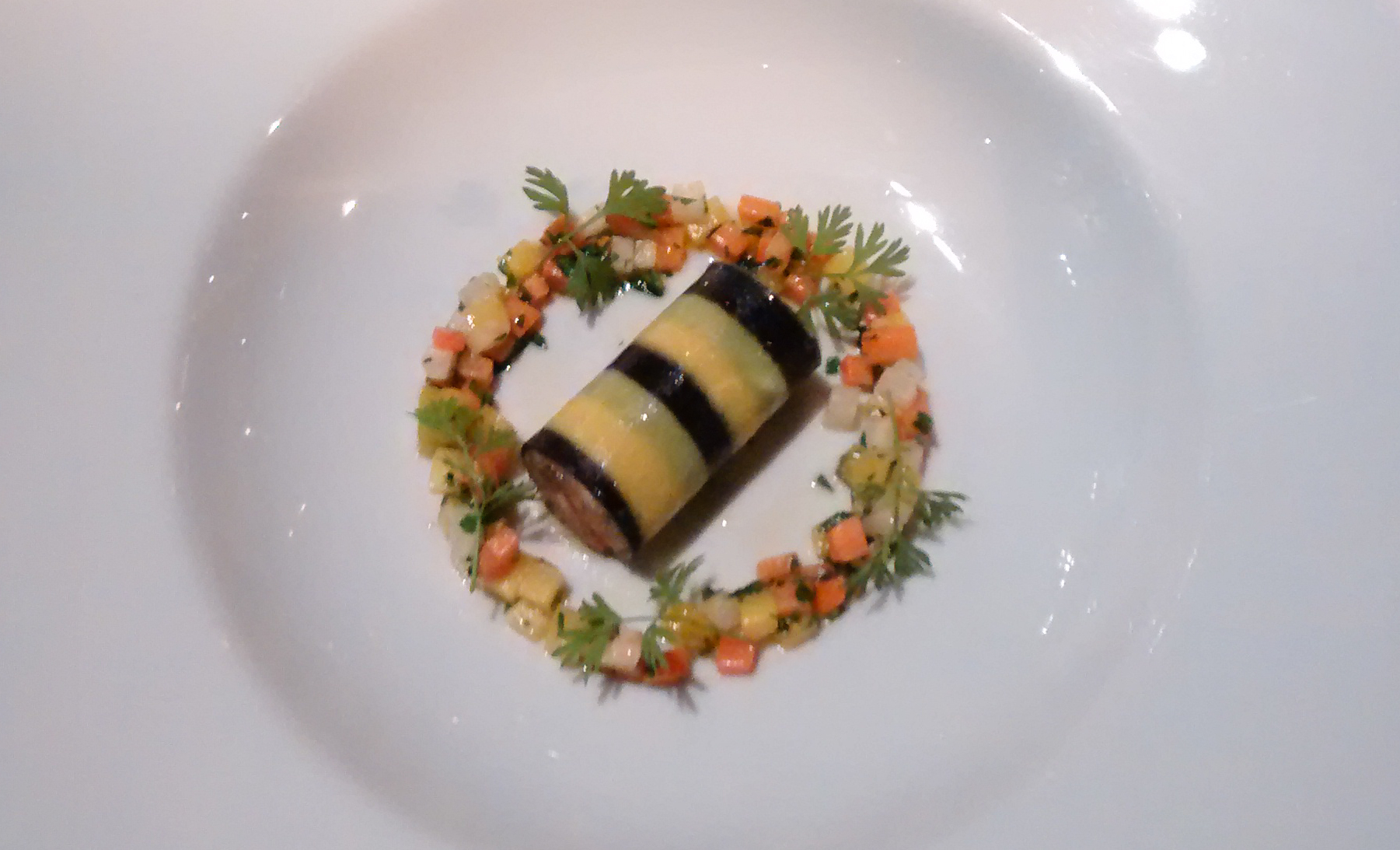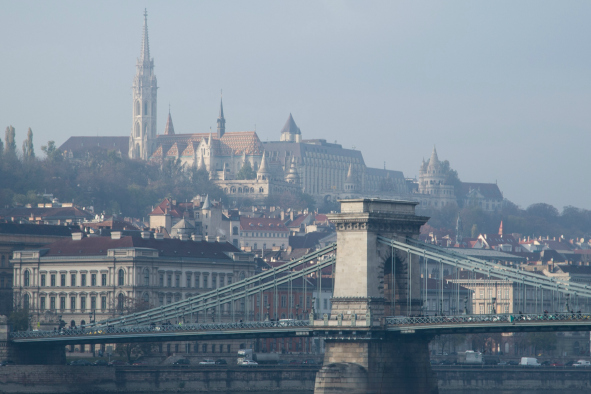Built on a foundation of hearty dishes, Hungary’s gastronomic heritage also encompasses politics, religion, and sumptuous luxury. With prices low compared to other EU countries, even its fledgling fine dining scene is accessible to most, although a guided food tour of the capital Budapest will satisfy both the physically hungry and the culturally voracious.

Pigs’ ears at Buja Disnok (Photo: Chris Allsop)
“Hungarian cuisine is meat with meat,” jokes my vegetarian guide, Borbala. At least I think she’s joking. Then my plate of deep fried pig’s ears arrives; three large triangular ears, breaded and topped with a whisper-thin cross-section of green chilli. Who’s laughing now?
It’s early November in Budapest. It’s chilly, around 4°C, and I’ve arrived on the week when its famed Christmas Market is due to open. This year the market opening has coincided with the festival of St. Martin, a week-long period during which the latest vintages of the country’s wines are tasted, usually paired with some of the homegrown foie gras (Hungary is second to France for production of goose liver pâté).
Intrigued to learn more about a gastronomic heritage that I’d ignorantly assumed was all about goulash and paprika, I booked a foodie tour and met with chatty Borbala (her name one of several versions of ‘Barbara’ available in the intimidatingly accented Hungarian language). My pig’s ear lunch (€6) was the first stop, procured from one of the few ear vendors in the city, Buja Disnok, located on the second floor of a 19th century food market (Hold utca 13). The pig’s ear is something of a local delicacy, and was served with potato salad and tartar sauce. The ears and I don’t get on; cutting into the thin sheaf of meat, the wiggly, wobbly consistency of ear is still too evident for me to progress beyond a single mouthful. Happily, Borbala carefully boxed the leftovers for her boyfriend.
Cross-border Seasoning
Afterwards, we strolled through Budapest’s stately streets. Borbala confirmed that paprika is one of Hungarian cuisine’s primary ingredients (the best is farmed in an area near the southern border with Serbia), but that was hardly the whole story. During the time of the Austro-Hungarian Empire, French chefs employed in Hungary emancipated the neglected local dishes from the overbearing influence of Austria, returning hearty, local classics to the national diet. It also transpires that the entire country is essentially one large wine region (divided into 22 appellations), with a wine-making history dating back to Roman-times.

Gerbeauds for the eating (Photo: Chris Allsop)
Not far from the banks of the Danube, we stopped into Gerbeaud Café (gerbeaud.hu) which has been intimidating casual visitors with its crystal chandeliers and pink marble floor since 1858. Emil Gerbeaud, a Swiss born in Budapest, was a famed pastry innovator, and even has his own eponymous goodie (€6) built of layers of apricot jam and walnut cream sealed in chocolate. It looks good enough to propose with. Aware that there are numerous eating stops scheduled, I restrain myself. A wise decision. Minutes later we’re at a graffitied street stall buying a ‘kürtőskalács’ or cinnamon funnel cake (€1), a traditional warming treat of coiled, bready stodge (it’s a perfect treat for citizens of a country where winter temperatures regularly plunge to -10°C). And about ten minutes after that, the funnel cake still warm and expanding in my stomach, we’re in the trendy Jewish Quarter trying a flodni (€4) pastry at Raj Rachel (torta.hu), one of the few shops where the flodnis have the all-important addition of plum jam as a top layer to this tasty Hungarian-Jewish cake.
But it’s good old goulash that’s the star of my tour, or rather the renowned goulash soup (€6) at Gettó Gulyás (Wesselényi u. 18) just across the street from Raj Rachel. ‘Goulash’ is the name for an Hungarian cowboy, and the authentic recipe involves beef stewed with potato, onion, and carrots (and paprika, obviously). The soup is light, spicy, flavourful, with cubes of carrot and potato bobbing up from the leather-brown depths. Perfect for when watching cattle on the Carpathian Basin and considering a career change as sub-zero gales chap your cheeks.
Modern Flavour
That evening, armed with Borbala’s culinary fundamentals, I stop in to the Borkonhya Wine Kitchen (borkonyha.hu). One of Budapest’s few Michelin-starred restaurants (although fine dining arrived in Budapest in the late 1990’s), the Borkonhya’s interior is a stylish take on the traditional bistro, and the ambiance is relaxed and distinctly smart-casual. Except in the kitchen, with the chef Ákos Sárközi bringing a somewhat more rock n’ roll vibe to the proceedings. Not your usual Michelin-starred chef, the warm and boisterous Sárközi has a tattoo sleeve on his right arm with the Michelin star inked near his wrist.

Fancy eating at Borkonhya (Photo: Chris Allsop)
Besides the delicious food, the best bit about eating in Budapest is the prices, about half what you would expect at an equivalent Michelin restaurant in London, for example. Borkonhya is not the cheapest in town (a main of pork belly with parsley cake and zucchini rolls will set you back about €14), but with all the money saved elsewhere on your travels through Budapest, a special occasion evening here is highly recommended.
I order the tasting menu, but, as is my wont, begin to ruin my appetite with the delicious bread. There’s black bread coloured with squid ink, and slices of a cumin-laced loaf that’s a nod to practices from the communist days when restaurants like Borkonhya were but a repressed Hungarian foodie’s fever dream. That said, most of the Hungarians I spoke to seemed at ease with memories of their communist period, and in fact, some of the older generation yearn for its return, nostalgic for the period’s simplicity. Hungary’s particular brand of ‘Goulash Communism’, as it was known, was a more liberal form of communism than elsewhere in the Eastern Bloc. The name refers to its mixed ideology (rather than the literal dish), as well as the fact that Hungarians had enough to eat during this period.
But it’s all a far cry from the exquisite Borkhonhya tasting menu that parades across my place setting. Foie gras with shards of fresh rhubarb. Striped pasta filled with partridge meat and served with a broth that billows umami meat fragrances. A cube of perch balanced on a cabbage and bacon rosti. When I eventually stagger out into the near zero evening air, I’m glad for the walk back to the hotel.

The Chain Bridge and Buda in the distance (Photo: Chris Allsop)
The dazzling technical feats of Borkonhya are more the exception rather than the rule when it comes to modern dining in Budapest (although the friendly and attentive service you’ll find there is replicated across the city). The next day, crossing the famous Chain Bridge over the serenely flowing Danube, I hiked up the hills of picturesque Buda – the more upmarket end of town – to the Military History Museum. When I emerged from the extensive exhibitions, trying to imagine the bloody Soviet siege of Budapest that brought an end to Hungary’s role in the Second World War, the clement weather had been replaced by sheets of icy rain falling from a low, slate-grey sky. Fortunately, through the gloom, the bright red awnings of Baltazár glowed.
Baltazár is a boutique hotel with a whiff of steam punk about its lobby. Its in-house grill offers Hungarian classics in fairly typical Shoreditch-hipster surrounds. A grid of industrial bulbs somewhat self-consciously light the lively interior, but despite the all-too-Western European aesthetics, the menu was reassuringly Hungarian. My chicken paprikash with buttered dumplings (€12), accented with dollops of sour cream (another traditional Hungarian side) arrived in double quick time. The hearty portions, typical of a traditional Hungarian restaurant, defeated me, but I was suitably restored to brave the icy conditions and catch a return bus back to Pest.
That evening I returned to the Jewish Quarter, the narrow sidewalks busy with youthful backpackers and elegant Hungarian couples. Passing Street Food Karaván – a cool cul-de-sac of food trucks and eateries – I saw people queuing for langos: circles of pizza-sized dough deep fried in oil before toppings are added (a local tongue-in-cheek nickname for langos is ‘communist pizza’). Tempting as they looked, I had a reservation at Spiler Original, a large, modern bistro located in the lively Gozsdu Udvar arcade. With the majority of the famed ruin bars in this district, Spiler is an appropriate starting point for a night exploring the neighbourhood’s eclectic charms. Strung with Christmas lights, playing dance music, and offering Pornstar Martinis and My Thai Lady (wink, wink) on the cocktail list, at first glance this ‘bistropub’ appears to be fly paper for stag and hen dos. But there was not a single inflatable penis or mankini on show the night I attended, and the other diners were a generally urbane mix of couples and small groups.

Bottle of sweet Tokaj wine (Photo: Chris Allsop)
Hungarian specialities are available here (chicken paprikash with buttered noodles is about half price compared with pricey Buda-based Baltazár) alongside your standard burgers and steaks catering for the tourists. I plumped for the homemade mangalica pork and Tokaj wine sausage with French fries (€5.50). Mangalica is a particularly furry breed of Hungarian pig, while Tokaj is easily Hungary’s most internationally recognised wine, a sweet and honeyed tipple, produced in the north of the country, that made this banger melt-in-your mouth delicious and perfect with the local mustard’s lingering heat. And, to my surprise, two sheafs of unasked for lettuce on the side. Hungary’s vegetarians would be proud.
Book your own:
Taste Around Budapest Tour – four hours touring Budapest’s downtown and exploring – and tasting – its multi-faceted culinary heritage with a knowledgeable guide. Rates (which include all food and drink) start from €129 pp. www.underguide.com
Where to stay:
Upper: Hotel Moments Budapest
Centrally located near to St. Stephen’s Basilica, the recently renovated Hotel Moments offers a luxurious experience at a third of the price of other high end options in the city centre. Breakfast included in the price. Rooms start at €130 per night. http://hotelmomentsbudapest.hu
Mid: Hotel Parlement
A stylish hotel only ten minutes’ walk from the Jewish Quarter. Excellent breakfast included in the price, as well as free coffees until 5pm (and even a little after if you ask politely). While it doesn’t have its own restaurant for dinner, just around the corner is Bistro Fine – a superb modern Hungarian bistro that offers traditional as well as modern cuisine, and welcomes customers with a glass of Hungarian sparkling wine. Rooms from €100 per night. http://parlament-hotel.hu
Budget: Penthouse Privates
Cheap and cheerful hostel right in the heart of the bar-hopping action. Room only from €18 euros. http://penthouseprivates.insta-hostel.com